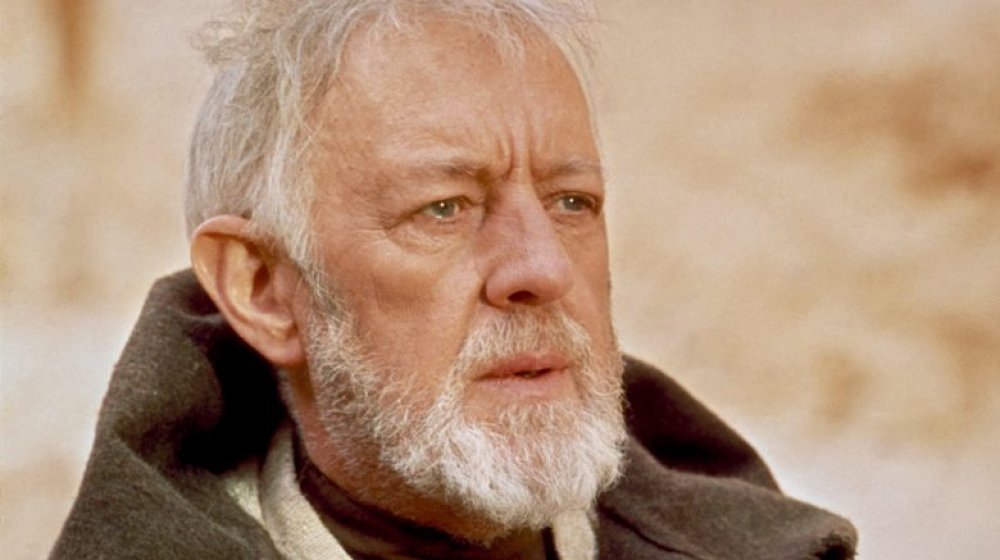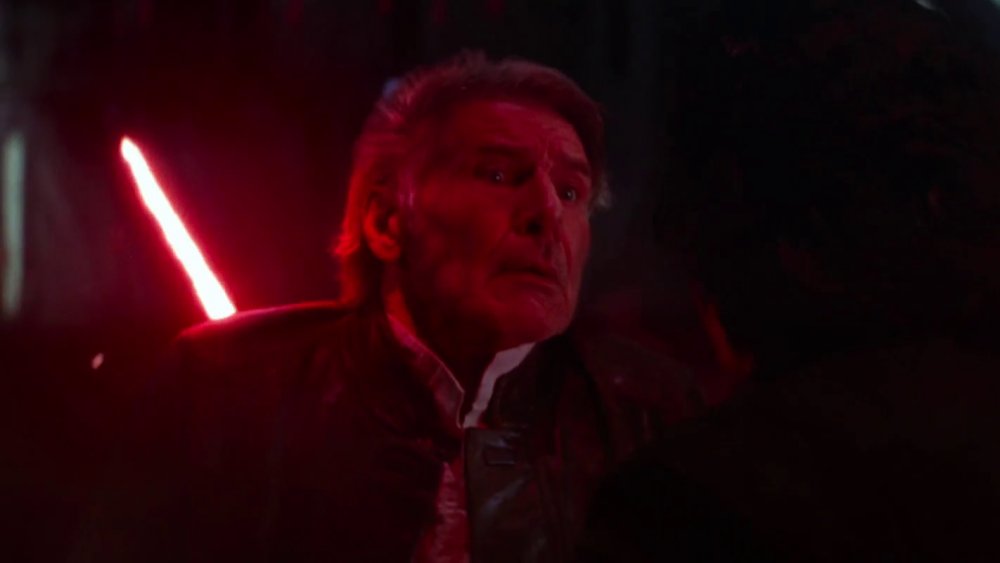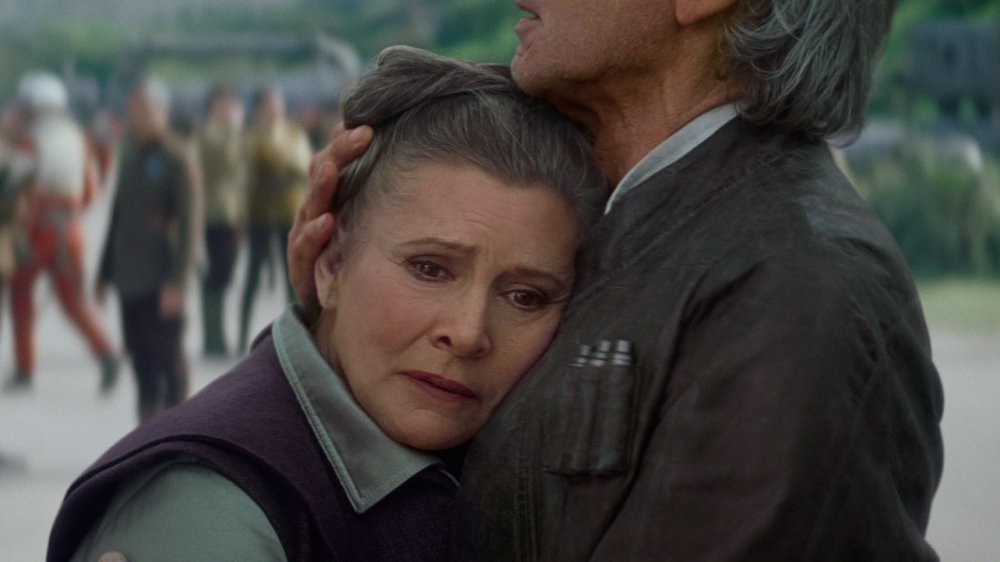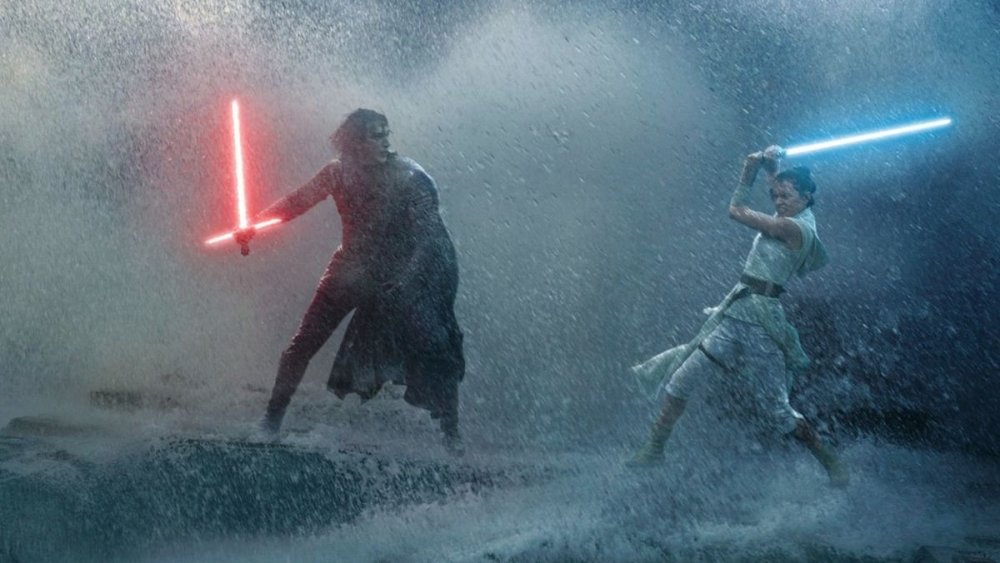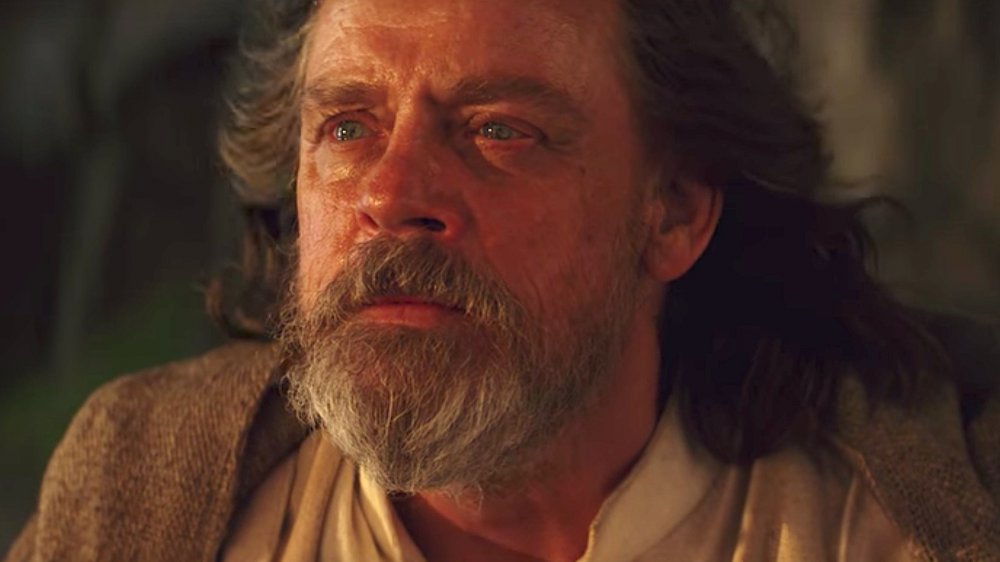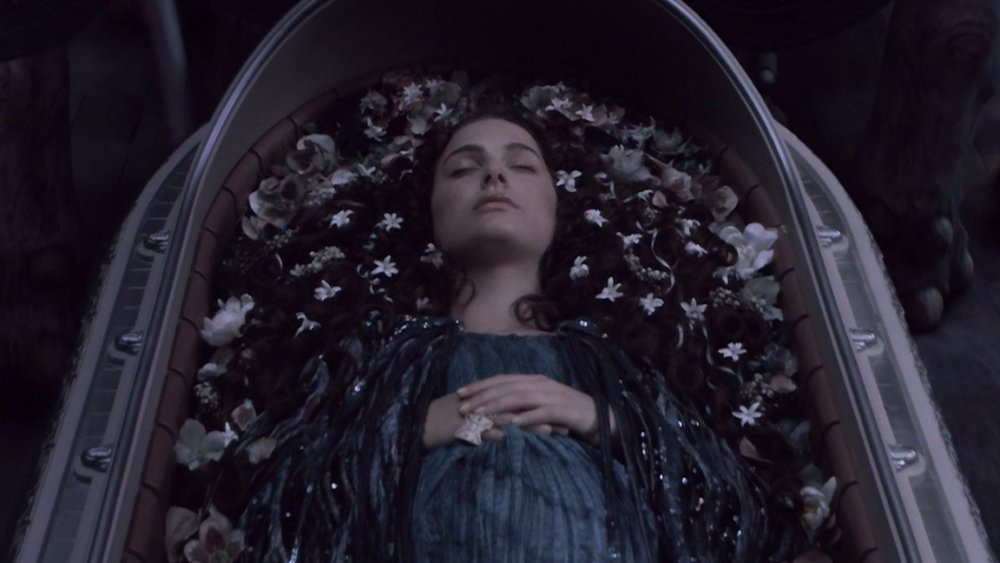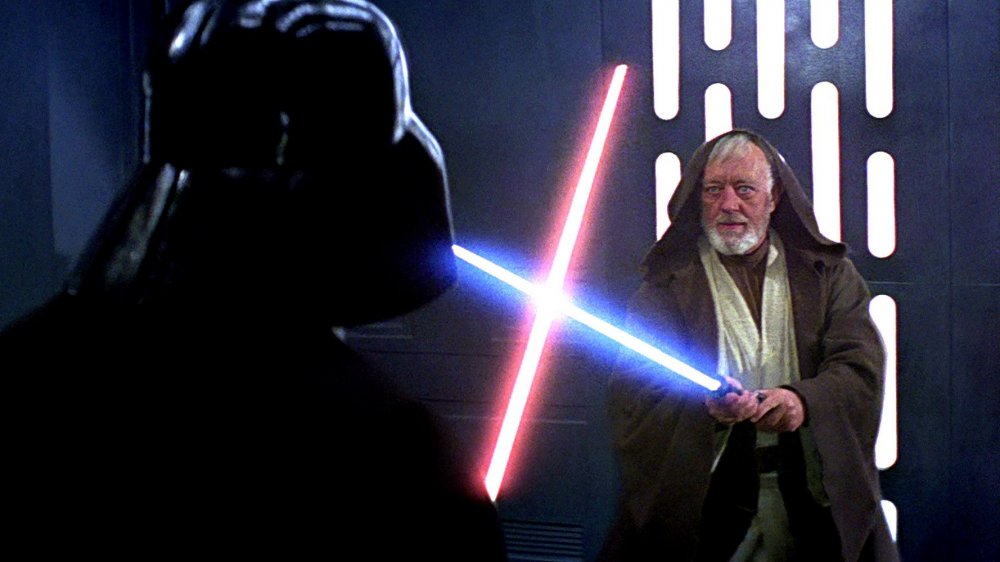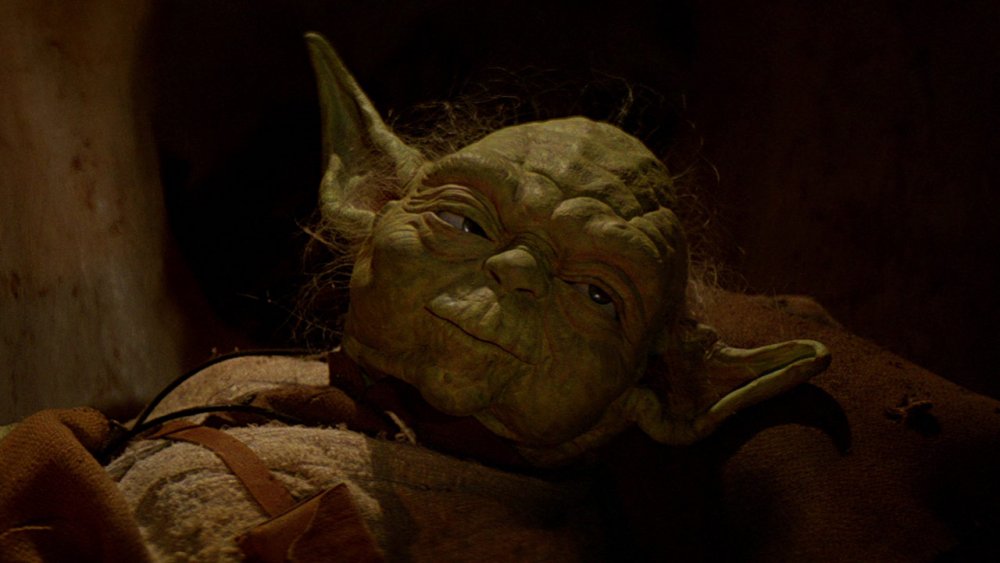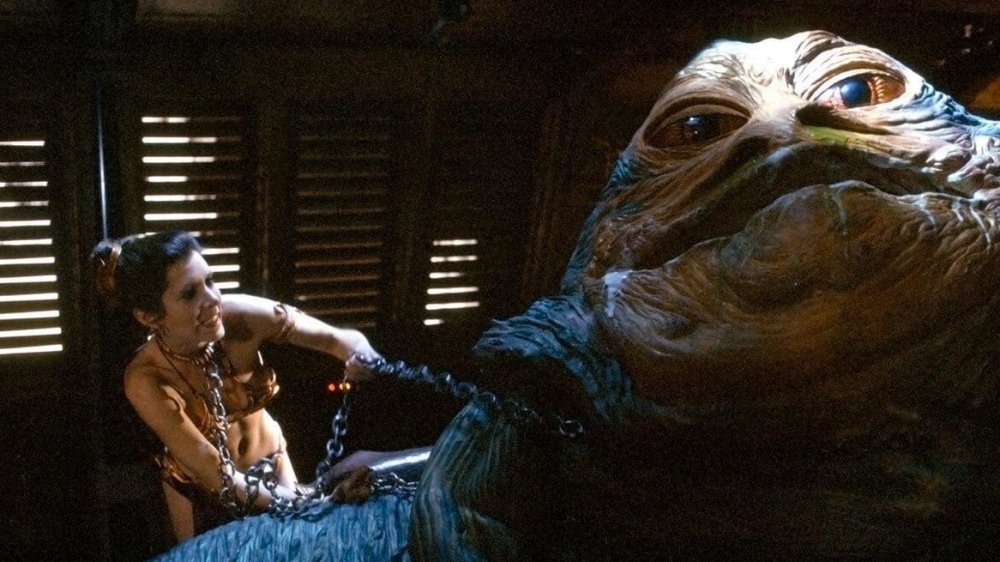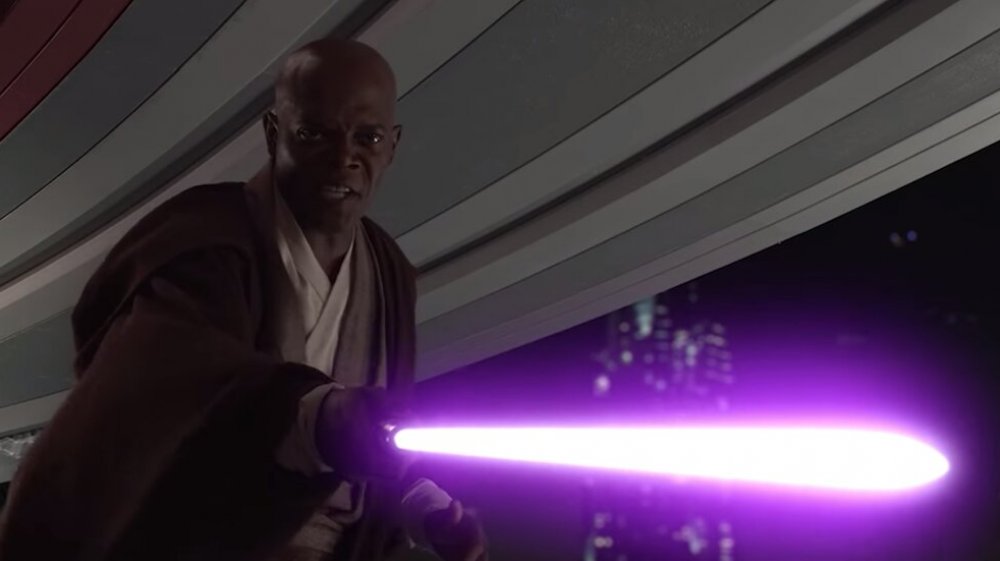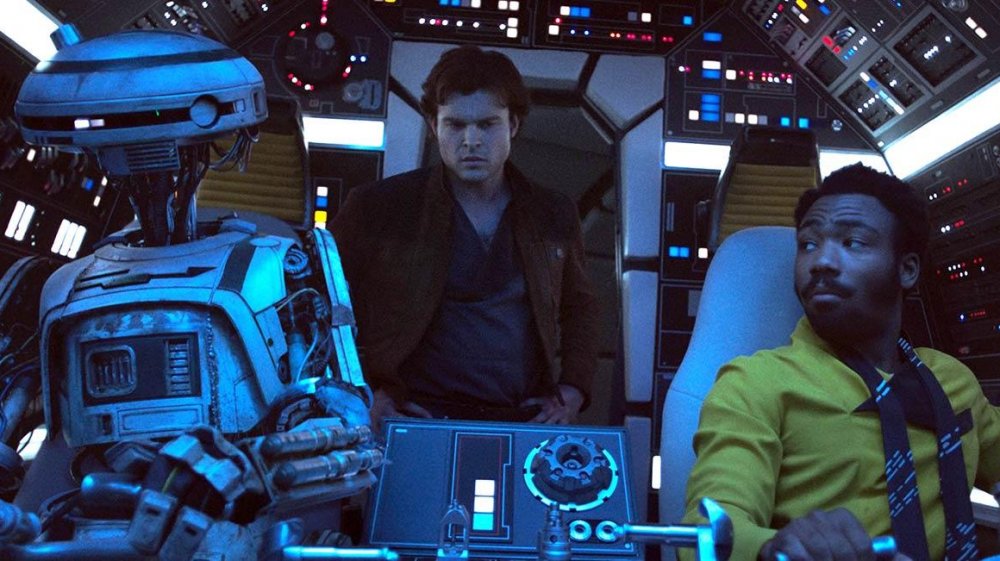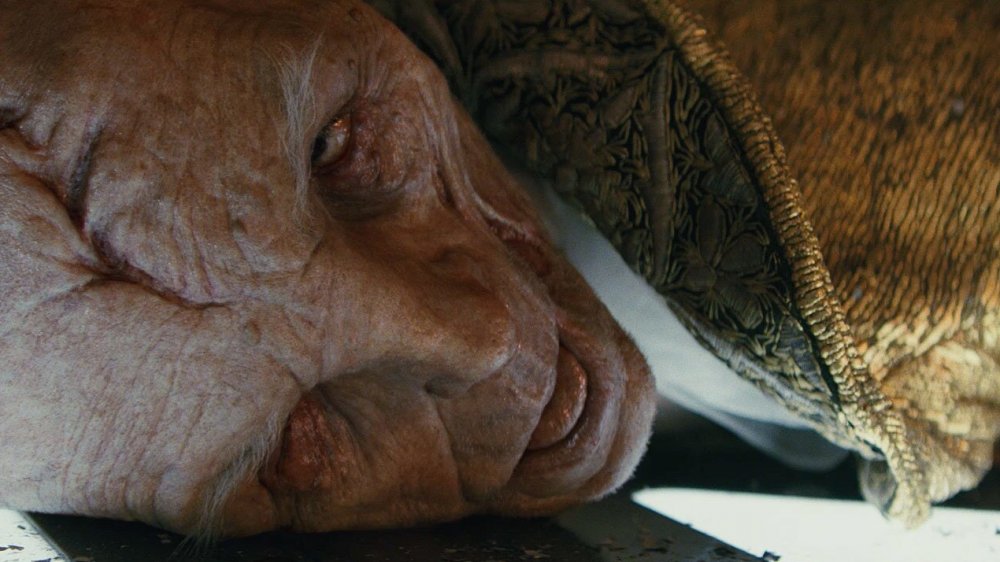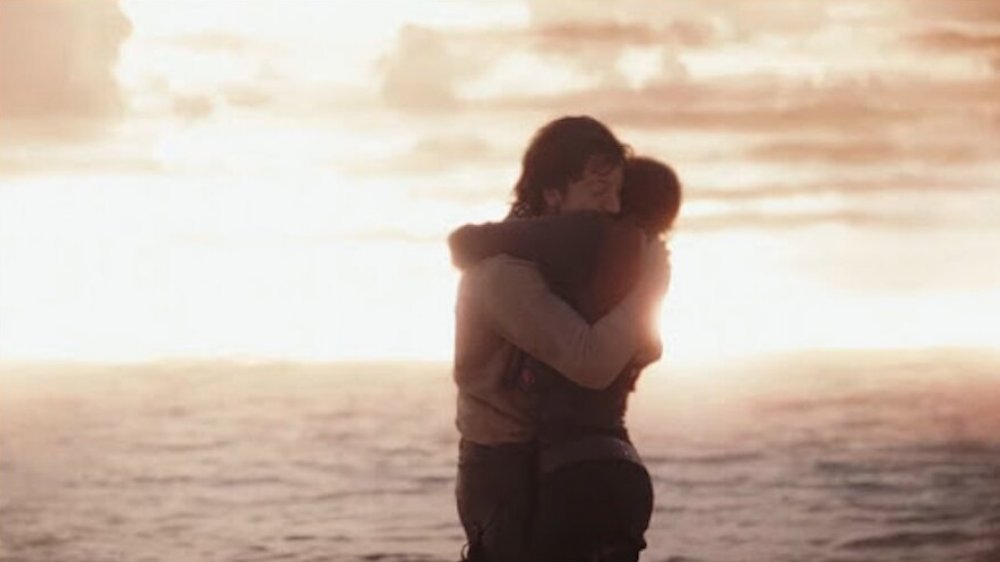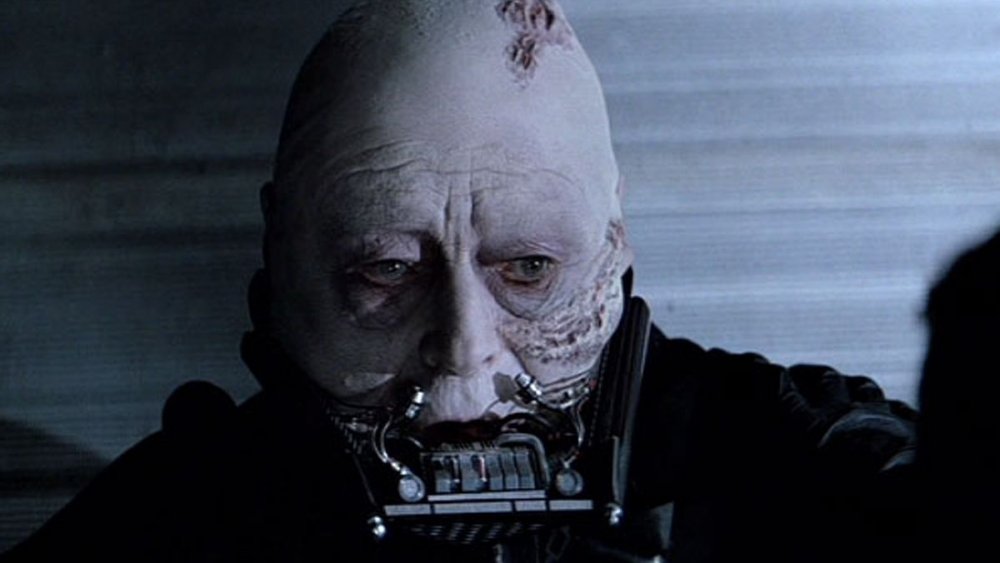Why These Star Wars Characters Had To Die
Rebellions may be built on hope, but they're also built on death, and Star Wars doesn't shy away from killing off fan favorites. The series may heavily focus on a mystical zen religion, but despite the lightsabers and Jedi mind tricks, at its core, the franchise revolves around war. And in war, there are casualties.
Fans have shed many a tear over the deaths of beloved characters since Star Wars: A New Hope released in 1977. But, as it goes, what's traumatizing for a fan base is usually vital to move the plot forward. Characters like Obi-Wan Kenobi and Luke Skywalker have to meet their maker to restore the galaxy to its former peaceful glory. And whether they're rebels fighting the good fight against a totalitarian regime or megalomaniacs trying to rule the galaxy, without these deaths, Star Wars wouldn't be the same. Love it or loathe it, these deaths had to happen.
Han lets Kylo kill him in Star Wars: The Force Awakens
Han Solo is marked for death the minute he greets his masked son in The Force Awakens. Kylo Ren teeters on the edge of light and dark for most of his screen time, but nothing says "taking a stance" quite like murdering your father in cold blood when your scraggly looking boss demands it. Ben Solo basically asks Han for permission to kill him, and with a single glance, the recovering smuggler appears to know exactly what his son is about to do. He forgives Ben for murdering him before the jaded Jedi even whips out his lightsaber.
While this was heartbreaking for fans, it was a relief for Harrison Ford. In an interview with USA Today, the actor admitted, "I wanted [Solo] to die for a long time, so I finally talked them into it." However, he clarified that he didn't just want Han to die to "dispose of him" but to "ennoble his participation" in the story.
Okay, so Ford wanted him dead, but why did it have to happen in the story itself? Well, Han Solo has to die to make fans believe Ben is beyond saving. Without committing one of the most egregious acts in Star Wars canon, Kylo Ren would never fully commit to his role as a villain, and Han wouldn't die a hero trying to protect his son. Without a single move to defend himself, Han Solo lets his son murder him, dying with a lingering hope that Ben's mother may save their son yet.
Leia gifts Star Wars fans a final ray of hope
The tragic loss of Carrie Fisher was a devastating blow to those she touched with her brutally honest wit and iconic portrayal of Leia. However, General Organa's fate was shrouded in mystery for years after Fisher's passing. After all, Leia was key to the Star Wars story. In fact, during an interview with Variety, Lucasfilm president Kathleen Kennedy said, "[Fisher] thought IX would be her movie. And it would have been."
So by virtue of heartbreaking real-world events, Leia's death was inevitable. But how were they going to film the scene without Fisher? Well, instead of getting a new actress or using CGI, the filmmakers decided to incorporate unused footage from The Force Awakens, with J.J. Abrams saying (via StarWars.com), "We desperately loved Carrie Fisher. Finding a truly satisfying conclusion to the Skywalker saga without her eluded us." Sure, the whole thing feels very improvised, but nevertheless, hope springs from Leia's sacrifice.
After descending to the Dark Side by killing his father, Kylo Ren's redemption in Episode IX stems from his mother's dying salvation, paralleling the event with a beacon of light. No one can convince someone to do something quite like General Leia Organa, and her son is no different. Cool, calm, and collected, Leia saves the galaxy far more than any of her male cohorts, and it's only fitting that she uses that voracity to save her son. Leia's funeral and subsequent mourning scenes are raw and full of heart-wrenching beauty fit for everyone's favorite space mom. Leia's hopeful sacrifice honors Fisher's incredible Star Wars legacy without distastefully writing her out of the film or killing her off-screen.
Kylo had to die to right Vader's wrong
Despite years of trying to be just like his grandfather, Ben Solo's final act proves just how different they are — and Anakin would be proud. The prequels revolve around Anakin's toxic love for Padmé, which destroys them both. Every shady decision Anakin makes is in the name of his one love, but each one rips the couple further apart. But The Rise of Skywalker hones in on redemption, with Ben honoring his grandfather not by mirroring his bad choices and questionable headgear but by doing what Anakin failed to do — save the one he loves.
Ben Solo's sacrifice to bring Rey back to life not only atones for his sins but Anakin's as well. Every single Skywalker before him sacrificed themselves for someone they love, even Vader. Sacrifice is the Skywalker way. After belatedly fulfilling the prophecy to bring balance to the Force, Ben and Leia's bodies disappear at the same moment. Finally, the last Skywalkers rest peacefully, knowing that they left the galaxy with one final ray of hope.
Luke finds serenity in his death
Luke struggles to keep his anger and impulsivity in check throughout the entire Star Wars series, giving the Dark Side a small taste of what could be if he gives in to its call. However, Skywalker always chooses to remain on the Light Side. Much like his father and his struggles with good and evil, that choice doesn't come naturally, and it continually takes work.
Luke's depiction in The Last Jedi is that of a tired man in his 50s who spent 30 years choosing to be good while watching so many others give into hate. He's exhausted and frustrated from seeing the same story unravel with each new Sith Lord and Dark Jedi that rises from the ashes of a fallen predecessor, embarking on yet another plot to rule the galaxy. In fact, he momentarily gives in to that anger himself, a decision that sends Ben Solo down the path of the Dark Side. As a result, Luke sequesters himself on the planet of Ahch-To, where he hopes for the Jedi Order to end.
However, Luke dies honoring the zen pacifism that he always wanted to reach but never fully mastered before his final scene. In his last moments, after defeating Kylo Ren through non-violence and helping Leia and company escape the First Order, Luke learns to let go of the guilt he carries for the choices of others. He knows he made a bad call almost hurting his nephew, but he finally holds Ben accountable for his own decisions. Luke's death is the final peaceful goodbye he deserves as he drifts away while saving his sister and bringing one final round of hope to the galaxy — all without hurting Ben.
Padme's fate scorches Anakin's humanity
Anakin Skywalker should be the poster boy for toxic relationships. Seriously, younglings, please run far away if your significant other is acting like this. While it's easy to get swept up in weird meadow montages that feel like they came straight out of The Sound of Music, Anakin and Padme's relationship is 50 shades of yikes. It was only ever going to end in heartbreak.
Time and time again, Anakin lets his anxiety of losing Padme twist him into a darker version of himself, pushing her away and allowing fear to fuel his every move. Instead of honoring the brightest parts of their love, he sinks into jealousy, rage, and doubt ... and Padme pays the price. And by unintentionally killing her when he was actually trying to save her life, Anakin becomes yet another victim of the self-fulfilling prophecy trope.
Even though she dies of a broken heart, Anakin is directly at fault for her death, and that knowledge burns off his final shred of humanity. Had Padme survived, Anakin would've never detached from that lingering shred of love to become Darth Vader. While Palpatine technically lies about Anakin killing Padme (before the twins' birth), the newly crowned Sith Lord might as well done the deed himself. (And he certainly tried.) Though Padme deserves a much better sendoff, her death was written in the stars before she even had a name.
Obi-Wan's death makes Luke a true orphan
Coming-of-age stories only work when circumstances force the main characters to fend for themselves. Luke needs Obi-Wan Kenobi to introduce him to the Force while offering him vague, bite-sized tidbits about his father. But beyond that, the Padawan needs to figure out this whole Jedi thing on his own.
Interestingly, in 2016, Peter Mayhew (Chewbacca) tweeted photos of an earlier draft of the New Hope script. And as it turns out, Obi-Wan was initially meant to survive the battle with Vader that would kill him in future edits. Without Obi-Wan's sacrifice, the film would end without an impactful on-screen death. Setting up the first film in a war franchise without killing a prominent character would completely remove the stakes for the upcoming films.
Sure, the devastating destruction of Alderaan captures the unmerciful nature of the Empire, but the film needs a face and an emotional attachment to bring it home. Obi-Wan grabs the short end of the lightsaber on that one, but his death lights a fire in Luke. He's determined now more than ever to take his place as a Jedi, even without a father-like figure to guide him. (And, come on, we all know that Force ghosts just aren't the real thing.)
Yoda passes the torch in Star Wars: Return of the Jedi
While it's arguable that Yoda dramatically dies to avoid dealing with Luke for one more minute, the Jedi Master's death actually has a huge impact on Luke's journey as a Jedi. After all, Return of the Jedi marks a turning point in the series, as Luke has to go out and face Vader and the Emperor by himself. If Yoda were by his side, then that quest would be a walk in the park, even though the little guy treats Luke like his own personal chauffeur.
However, with Yoda out of the picture, the young Skywalker has to rely on his own abilities and the training that he's received over the years. Plus, Yoda's death prompts the elderly sage to drop a big bomb about Luke's family tree, revealing that there's another Skywalker out there somewhere. But ultimately, losing Yoda raises the stakes. Now that he's on his own, Luke has to carry on the legacy of the Jedi by himself and the fate of the galaxy is in his hands alone. No pressure.
Jabba the Hutt messes with the wrong princess
Princess Leia quickly became a feminist icon in the '70s when A New Hope debuted. After all, no one needed to save this self-rescuing princess. She did just fine on her own. And that held true when Return of the Jedi rolled around and the hero went up against Jabba the Hutt, a greasy slug with a bad habit of chaining up young women.
After being forced into the creepy slave bikini that fans somehow still fetishize, Leia does what hundreds of smugglers before her could not do — kill the beast. Leia strangles the slimy crime lord with the very same chains he used to take away her freedom. Some might call that poetic justice. The "prince must save the princess" trope was long due for a rewrite, and Return of the Jedi delivers it on a silver platter, served fresh with a Hutt tongue.
The scene has become one of the most empowering feminist moments in cinematic history. Leia deserved a "yas, queen" before anyone even coined the phrase.
Mace Windu's death snuffs out Anakin's loyalty
Mace Windu is the only Jedi on the council who doesn't fully buy into all of the unwavering Jedi rhetoric. He's willing to break the rules, and Palpatine exploits that stance to sever the final tie that Anakin has to the Jedi. With Palpatine controlling the senate and the courts, Mace knows that putting the villain on trial would be futile, and the Sith Lord would get off scot-free. So Mace decides to go full-Dirty Harry, but attempting to cut Palpatine down (while the Sith Lord begs for his life) is what finally breaks Anakin.
Anakin is torn between his last shred of loyalty to the Jedi, doing what's right, and saving Padme. He uses Mace's perceived betrayal as an excuse to take Palpatine's side. However, he has a sliver of remorse when Palpatine kills his former colleague, muttering, "What have I done?" But Anakin's uncertainty quickly dissipates at the mention of Padme. Mace Windu dies an honorable death attempting to save the peaceful democracy the galaxy once held dear. But doing the right (wrong) thing prompts Anakin to become the villain he was fated to be, and history couldn't unfold any other way.
Don't tell that to Samuel L. Jackson, though. In an interview with Entertainment Weekly, Jackson assured the outlet that Mace is still alive. He even claimed that George Lucas signed off on his theory by saying, "I'm okay with that. You can be alive." It's easy to make those calls when you don't control canon anymore. But we could have used you, Mace. Where you at?
L3 becomes the Falcon in Solo: A Star Wars Story
L3-37, Lando Calrissian's feminist co-pilot from Solo: A Star Wars Story, lives her life fighting for others — ultimately sacrificing herself for the cause. After liberating a slew of her fellow droids, a guard guns her down, shredding her into unsalvageable pieces. Lando tears after her, risking his own life to collect a few of her vital bits, but saving the fearless droid is hopeless.
Lando is known for keeping his cards close to his chest, avoiding most outward signs of emotion with amped-up charm. But he falls apart when faced with the inevitability of losing his co-pilot, providing a glimpse of what's underneath his carefully composed capes.
In the wake of her death, Han decides to try to upload her memory to the Falcon's navicomputer. He would never have made the Kessel Run in less than 12(ish) parsecs without her data bank. L3 dies doing what she loves most, all while becoming a vital part of the most famous ship in the galaxy. When Han calls the Millennium Falcon "she," the "she" he's talking about is, in part, his old comrade, L3.
Snoke goes up in smoke
The original trilogy and the prequels feature Anakin and Vader as the central focus over Palpatine, but neither version of the character ever runs the show. The Emperor always looms in the background, manipulating events and calling the shots. Had Vader been free to rule as he saw fit, fans may have witnessed an unconventional side of him that the series never fully explored.
On the flip side, Snoke's surprising and epic death allows an uninhibited Kylo Ren to take center stage. Without Snoke's death freeing up Kylo to find his own path, he may never have shed his angsty alter ego. Ben Solo and Kylo Ren are ruled by what others expect. Everyone pulls the young warrior in so many directions that he loses sight of who he is. Kylo continually wages war with himself, so yeah, Snoke isn't exactly what you'd call a good influence on the guy.
It's clear that Snoke's manipulation of Kylo is at odds with the young man's morals even after he turns to the Dark Side. It isn't until Snoke's demise that Kylo finally begins to think for himself, figure out who he truly is, and determine what kind of world he wants to establish. Had Vader turned on his own master earlier, Anakin may have reemerged for the opportunity to help his children build a better future than the one he tore down. Kylo made the choice Vader couldn't, but only after he killed his puppet master.
The destruction of Scarif in Rogue One: A Star Wars Story
Killing off the entire Rogue One ensemble was a bold and unexpected choice by Disney, but it had to happen. While everyone wants to see Jyn and Cassian fly off into the sunset, there's no efficient way to explain their absence from the rebellion in A New Hope without their deaths. Plus, their deaths shine a light on a key part of the Star Wars canon.
When the Death Star obliterates Alderaan in Episode IV, the bird's-eye view fails to portray the horror and devastation that an entire planet of people feel as they watch an explosion engulf their home and everyone in it. Plus, Leia never gets to grieve the loss of her adoptive family, home, or the billions of peaceful lives evaporated in mere minutes. Leia is always too busy comforting others to focus on herself, and no one addresses the fact that her father blew up her entire planet.
The original trilogy falls flat in representing the much-needed humanization of the Alderaanians during this swift act of genocide. However, Rogue One sheds light on what the Alderaan people must have felt while they watched everything around them burn. Instead of turning their final minutes into a swift make-out scene, Lucasfilm makes a much classier choice. Cassian Andor and Jyn Erso support and embrace each other as the sunset-looking explosion engulfs the planet of Scarif, giving the galaxy a small taste of what's to come.
Vader's death leads to his redemption
Hunting down your child and providing him with an unnecessary laser sword amputation is generally not considered chill behavior. But then again, chill isn't a word that anyone would attribute to Darth Vader or Anakin Skywalker. Overdramatic, sure. Chilly, maybe. But not chill. But even though Anakin Skywalker murders a group of younglings and Darth Vader is mostly okay with Palpatine ordering his son's death, the wayward villain isn't beyond salvation.
Hope fuels every fiber of the Star Wars franchise, and villains are no exception. Luke spends a significant amount of time trying to bring out an ounce of humanity in his father, finally succeeding at the 11th hour. Fans can mostly forgive Vader for his zero inquiries about Leia while he finally looks upon Luke with "his own eyes." But, really, would it have killed him (again) to ask Luke to apologize to Leia for him? He may have taken Luke's hand, but he took Leia's entire planet.
Flaws aside, Vader's death provides a tender moment of redemption to prove that no one is truly beyond saving — a stance that fuels the sequels and defines the franchise.
